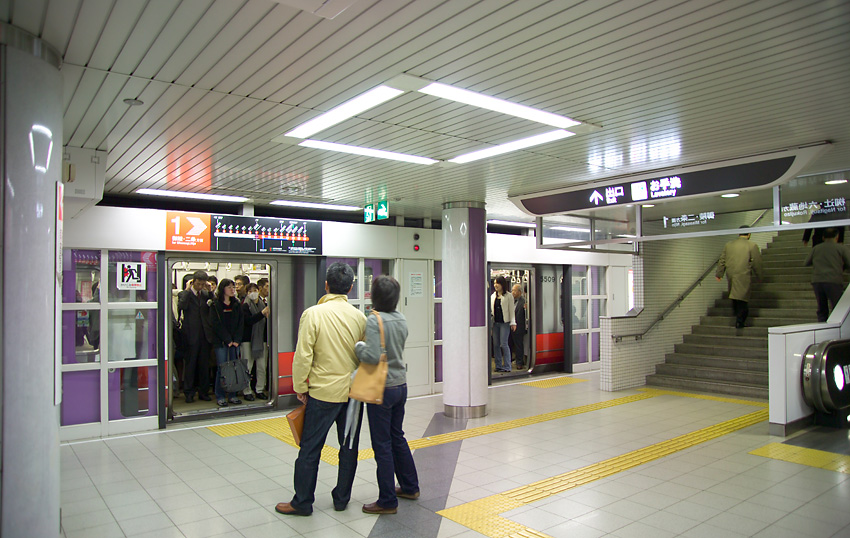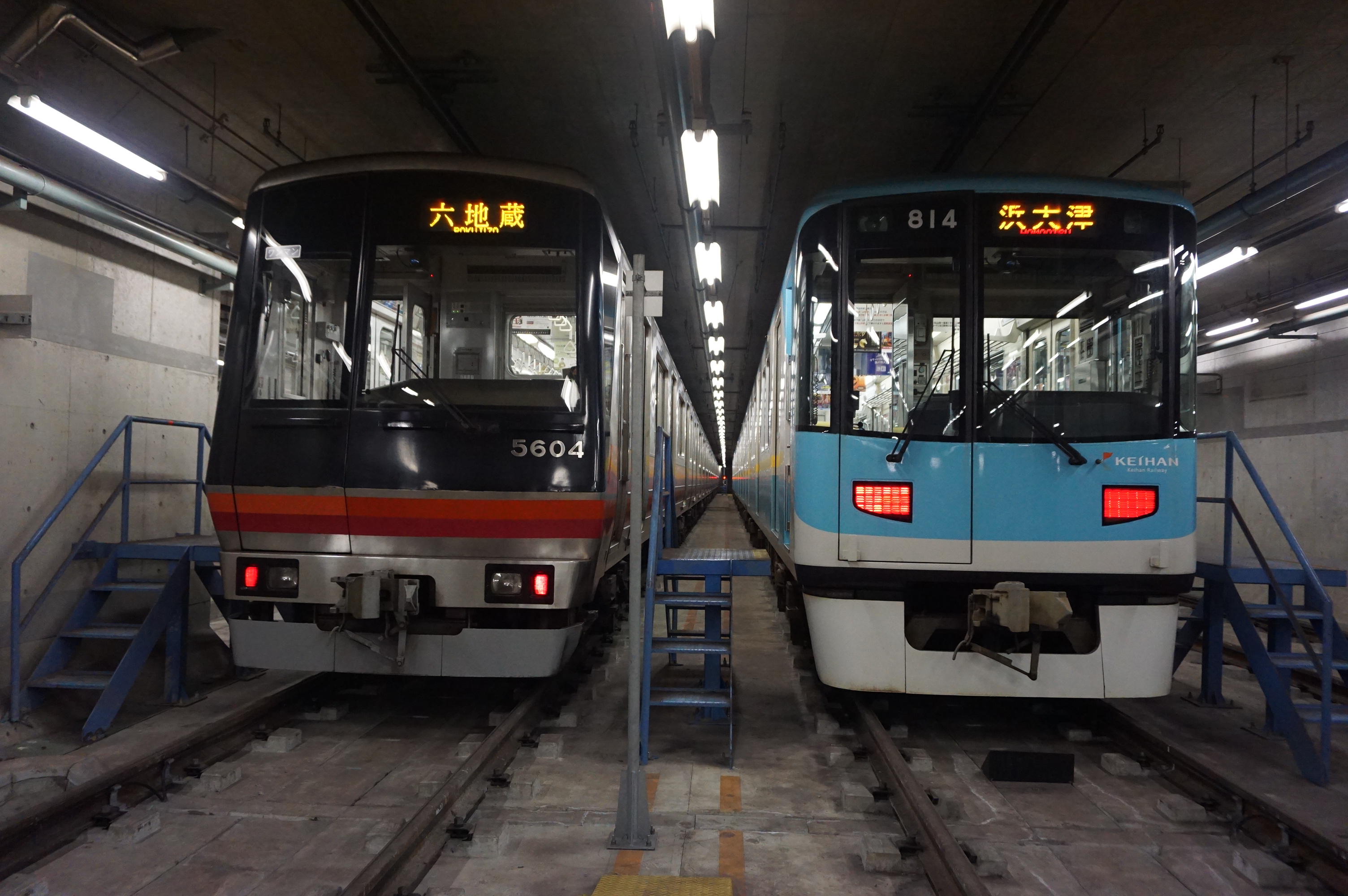Tōzai Line (Kyoto) on:
[Wikipedia]
[Google]
[Amazon]
The is a Kyoto City Subway line which runs from the southeastern area of the city (starting from Rokujizo Station), then east to west (i.e. ''tōzai'' in Japanese) through the 

Kyoto
Kyoto ( or ; Japanese language, Japanese: , ''Kyōto'' ), officially , is the capital city of Kyoto Prefecture in the Kansai region of Japan's largest and most populous island of Honshu. , the city had a population of 1.46 million, making it t ...
downtown area. The Kyoto Municipal Transportation Bureau
is an agency of the city government of Kyoto, Japan that operates municipal subways and city buses within the city. Previously, it also operated trams and trolley buses.
Subway
The Kyoto Municipal Subway operates the following two lines:
*Kara ...
operates the system along with the Karasuma Line and the City Bus. The present terminal stations are Rokujizo Station in Uji and Uzumasa Tenjingawa Station in Ukyō-ku, Kyoto
is one of the eleven wards in the city of Kyoto, in Kyoto Prefecture, Japan.
History
The meaning of ''ukyō'' (右京) is "on the Emperor's right." When residing in the Kyoto Imperial Palace the emperor would sit facing south, thus the west ...
. It handles an average of 241,133 passengers daily (2009 data).
The stations are wheelchair-friendly, with elevators, narrow gaps between platform and train, and no height differences at places like restrooms. Each station has a colour code for easy recognition. All platforms on the line are island platforms
An island platform (also center platform (American English) or centre platform (British English)) is a station layout arrangement where a single railway platform, platform is positioned between two railway track, tracks within a railway station, ...
, and have platform screen doors
Platform screen doors (PSDs), also known as platform edge doors (PEDs), are used at some train, rapid transit and people mover stations to separate the platform from train tracks, as well as on some bus rapid transit, tram and light rail ...
separating the platform from the tracks.
The line is long with a track gauge of . The entire length is double-track. Trains are electric, operating on 1,500 V DC. Trains travel between Rokujizō and Uzumasa Tenjingawa in 34 minutes.
On October 12, 1997, the section the line from Daigo to Nijō opened. On November 26, 2004, the line from Daigo to Rokujizō opened. An extension westward from Nijō to Uzumasa Tenjingawa began service on January 16, 2008.

Stations
Footnotes
Rolling Stock

Kyoto City Subway
* 50 seriesKeihan Electric Railway
* 800 series Kyoto City Subway trains are based at Daigo Depot, while Keihan Electric Railway trains are based at Nishigōri Depot located on the Keihan Ishiyama Sakamoto Line.History
Events leading up to construction
AfterWorld War II
World War II or the Second World War (1 September 1939 – 2 September 1945) was a World war, global conflict between two coalitions: the Allies of World War II, Allies and the Axis powers. World War II by country, Nearly all of the wo ...
, the Kyoto Municipal Transportation Bureau discussed the possibility of creating a new municipal streetcar system, connecting Rokujizō, Daigo, and Keage, before cutting along the centre of Oike-dōri (an elevated line was also considered). Before long, the proposal was at an impasse in the face of ever-increasing automobile
A car, or an automobile, is a motor vehicle with wheels. Most definitions of cars state that they run primarily on roads, Car seat, seat one to eight people, have four wheels, and mainly transport private transport#Personal transport, peopl ...
use in the city. However, the plan was eventually reworked as a subway line.
The population along the east-west route showed a considerable trend of growth, but road development in the vicinity could not overcome traffic congestion, so a plan for transportation facilities connecting the eastern part of the city (Yamashina-ku and the eastern portion of Fushimi-ku) with the city center was developed starting in 1965, and it was officially approved by the city government in 1969. The construction of the segment from Daigo to Nijō was set to start in 1975.
At that time, however, the Keihan Keishin Line ran above-ground between Misasagi and Sanjo Keihan along the planned route, and the issue of competition arose. As a result of negotiations, Kyoto City and Keihan Electric Railway agreed to establish a Third Sector (public-private partnership) company to obtain a Type-3 railroad business permit and control the tracks, while the City of Kyoto would obtain a Type-2 railroad business permit and operate the trains on that section. Thus the Kyoto Rapid Railway Corporation was born. Founded in 1986, then-mayor Masahiko Imagawa assumed duties as its president. Kyoto Rapid Railway constructed the subway through the Japan Railway Construction Group, and along with the Keihan Keishin Line's incorporation, the above-ground section was set to be eliminated.
Over the course of construction work underneath Kyoto, the project faced frequent, unavoidable interruptions due to discoveries of remains and ruins, and experienced difficult work in tunneling underneath the Kamo River
The is located in Kyoto Prefecture, Japan. The riverbanks are popular walking spots for residents and tourists. In summer, restaurants open balconies looking out to the river. There are walkways running alongside the river, and some stepping s ...
and Tōkaidō Shinkansen
The is a Japanese high-speed rail line that is part of the nationwide Shinkansen network. Along with the San'yō Shinkansen, it forms a continuous high-speed railway through the Taiheiyō Belt, also known as the Tokaido corridor. Opening in 19 ...
. The section from Daigo to Nijō opened in 1997, and the Keihan Keishin Line was integrated from Misasagi to Kyoto Shiyakusho-mae.
The reason that the Keishin Line does not terminate at Sanjo Keihan as it originally did when above-ground, is that the necessary amount of space for a returning track could not be provided (not only is there a sharp curve directly to the west of that station, but the extra dead-end track would be directly underneath the Kamo River, so it was not feasible). The reason it did not originally continue to the (then-)terminus at Nijō was for the Kyoto Municipal Transportation Bureau to keep the calculated costs of running the trains balanced. However, since the opening of the extension in 2008, this is no longer the case and trains of the Keishin line now continue to the present terminus at Uzumasa Tenjingawa.
When the above-ground Keishin Line portion was demolished, Kujōyama Station and Hinooka Station (which have no subway counterparts) were demolished as well. City residents who lived near Kujōyama Station demanded that there be a Kujōyama subway station, but due to anticipated difficulties in construction (local topography would have either made a station on the subway line as it stands extremely deep or required steep grades on either side), as well as an insufficient estimated number of riders, this request went unfulfilled.
Extension west
A plan exists to extend the Tōzai Line as far west as Rakusai in Nishikyō-ku, but for the time being, the extension will be stopped at Uzumasa Tenjingawa; prospects beyond that are as-yet still unclear. There are several issues to be considered: *The population of RakusaiNew Town
New or NEW may refer to:
Music
* New, singer of K-pop group The Boyz (South Korean band), The Boyz
* New (album), ''New'' (album), by Paul McCartney, 2013
** New (Paul McCartney song), "New" (Paul McCartney song), 2013
* New (EP), ''New'' (EP), ...
is holding steady or decreasing;
* Rakusaiguchi Station on the Hankyū Kyoto Main Line and Katsuragawa Station on the JR Kyoto Line are already in service, so the inconvenience of transportation in that area has already been resolved to a degree;
*The subway's high construction costs;
*and the population of the Umezu and Kamikatsura districts leading into Rakusai New Town along the route are not very large.
Timeline
*October 12, 1997: Opening of the section from Daigo to Nijō. The Keihan Keishin Line is incorporated into the subway. *November 26, 2004: Opening of the section from Rokujizō to Daigo. *January 16, 2008: Opening of the section from Nijō to Uzumasa Tenjingawa.Sights of note along the line
* Daigo Station: Daigo-ji, a Buddhist temple with a pagoda andJapanese garden
are traditional gardens whose designs are accompanied by Japanese aesthetics and philosophical ideas, avoid artificial ornamentation, and highlight the natural landscape. Plants and worn, aged materials are generally used by Japanese garden desig ...
; connections to Toyotomi Hideyoshi
, otherwise known as and , was a Japanese samurai and ''daimyō'' (feudal lord) of the late Sengoku period, Sengoku and Azuchi-Momoyama periods and regarded as the second "Great Unifier" of Japan.Richard Holmes, The World Atlas of Warfare: ...
* Kyōto Shiyakusho-mae Station: Kyoto City Hall; nearby, the rebuilt Honnō-ji, the original of which (in another part of the city) burned in the attack by Akechi Mitsuhide
, first called Jūbei from his clan and later from his title, was a Japanese ''samurai'' general of the Sengoku period. Mitsuhide was originally a bodyguard of the last Ashikaga shogunate, Ashikaga ''shōgun'' Ashikaga Yoshiaki and later, one of ...
against Oda Nobunaga
was a Japanese ''daimyō'' and one of the leading figures of the Sengoku period, Sengoku and Azuchi-Momoyama periods. He was the and regarded as the first "Great Unifier" of Japan. He is sometimes referred as the "Demon Daimyō" and "Demo ...
* Nijō-jō-mae Station: The Nijo Castle of Tokugawa Ieyasu
Tokugawa Ieyasu (born Matsudaira Takechiyo; 31 January 1543 – 1 June 1616) was the founder and first ''shōgun'' of the Tokugawa shogunate of Japan, which ruled from 1603 until the Meiji Restoration in 1868. He was the third of the three "Gr ...
References
{{DEFAULTSORT:Tozai Line (Kyoto) Kyoto Municipal Subway Standard-gauge railways in Japan Railway lines opened in 1997 1997 establishments in Japan